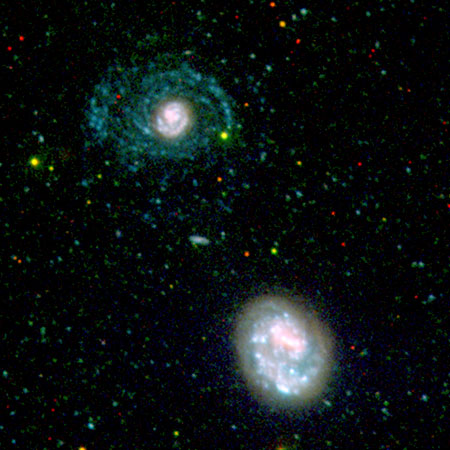GALEX Image

Hello to Arms
This image highlights the hidden spiral arms (blue) that were discovered around the nearby galaxy NGC 4625 by the ultraviolet eyes of NASA's Galaxy Evolution Explorer.
The image is composed of ultraviolet and visible-light data, from the Galaxy Evolution Explorer and the California Institute of Technology's Digitized Sky Survey, respectively. Near-ultraviolet light is colored green; far-ultraviolet light is colored blue; and optical light is colored red.
As the image demonstrates, the lengthy spiral arms are nearly invisible when viewed in optical light while bright in ultraviolet. This is because they are bustling with hot, newborn stars that radiate primarily ultraviolet light.
The youthful arms are also very long, stretching out to a distance four times the size of the galaxy's core. They are part of the largest ultraviolet galactic disk discovered so far.
Located 31 million light-years away in the constellation Canes Venatici, NGC 4625 is the closest galaxy ever seen with such a young halo of arms. It is slightly smaller than our Milky Way, both in size and mass. However, the fact that this galaxy's disk is forming stars very actively suggests that it might evolve into a more massive and mature galaxy resembling our own.
The armless companion galaxy seen below NGC 4625 is called NGC 4618. Astronomers do not know why it lacks arms but speculate that it may have triggered the development of arms in NGC 4625.
Credit: NASA/JPL-Caltech/Carnegie Observatories/DSS
Release Date
July 25, 2005
Download Options
- Full Resolution TIFF [872x872, 1.2 MB]
- Full Resolution JPEG [872x872, 912 KB]
- Screen Resolution JPEG [450x450, 60 KB]